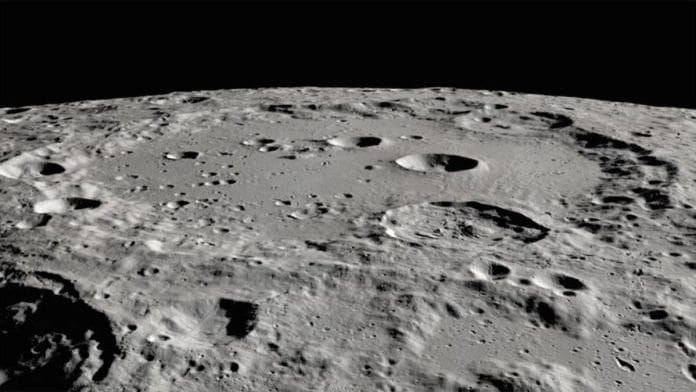New Delhi: Astronomers have long observed a very thin lunar exosphere, formed out of an almost invisible layer of atoms, hovering over the Moon’s surface. Research from MIT and the University of Chicago, published in Science Advances journal on 2 August, has identified “impact vaporisation” as the main process forming and sustaining this atmosphere.
The scientists analysed lunar soil samples from NASA’s Apollo missions for this study. They found that over the Moon’s 4.5-billion-year history, it was continuously bombarded by meteorites and dust-sized micrometeoroids that vaporised the surface-level atoms of the Moon.
This constant vaporisation created an almost permanent exosphere made up of the lunar dust commonly known as ‘regolith’. The study indicates that approximately 70 percent of the Moon’s atmosphere is due to these impacts, with the remaining 30 percent attributed to solar wind, which transfers charged ions from the sun across space. This finding is a step forward in uncovering the Moon’s atmospheric and geological history. Read more here.
Also read: The Penguin & the Egg — Webb telescope captures the ‘embrace’ of two galaxies
24-million-year-old penguin fossil reveals key evolutionary history of penguin wings
A study published in the Journal of the Royal Society of New Zealand on 31 July unveils a new species of fossil penguin — Pakudyptes hakataramea — discovered in Otago, New Zealand. This 24-million-year-old penguin, comparable in size to the modern little blue penguin, provides critical insights into evolution and especially how current penguin wings came to be.
The study analysed three bones — humerus, femur, and ulna — to fill the gap of understanding between older and modern penguins. The findings reveal that Pakudyptes has wing bone structures indicating the exact evolutionary transitions between the two. The shoulder joints of the fossil resemble modern penguins, while the elbow joints align with older penguins.
The fossil penguin could also dive in water, which was evident in its bone anatomy. The study underscores Pakudyptes’ role in the rapid evolution and ecological diversity of penguins between 24 to 16 million years ago. Read more.
In new breakthrough for solar energy, scientists boost efficiency of perovskite solar cells
A new paper by the Hong Kong University of Science and Technology (HKUST) looks at the enhanced efficiency of solar cells specifically made of halide perovskite. The HKUST website explains how their scientists have developed a molecular treatment for passivating perovskite cells, which reduces defects and improves their performance. This breakthrough could accelerate the large-scale production of renewable energy, said the HKUST press release.
The study looked at the deficiencies of halide perovskites, a promising photovoltaic material, and focused their research on “amino-silane” molecules which are used as either coupling agents or surface modifiers on different industrial materials.
The research showed that amino salines indeed enhanced perovskite films’ surfaces, leading to a higher photoluminescence quantum yield and better quality. Rigorous testing showed that their solar cell prototypes maintained high efficiency and stability. The treatment process is compatible with industrial-scale production, so it can be integrated into existing manufacturing processes. This advances perovskite solar cells as a viable option for mainstream renewable energy generation. Read more here.
Antibiotic compound GmPcides found to act against flesh-eating bacteria
Researchers at Washington University School of Medicine in St. Louis have developed a new antibiotic compound called GmPcides, showing efficacy in treating severe bacterial infections in mice. Published in Science Advances on 2 August, their paper discussed how GmPcides PS757 targets a broad spectrum of gram-positive pathogens that cause illnesses, including Streptococcus pyogenes, known for causing “flesh-eating” diseases.
The ‘flesh-eating’ part of bacterial infections is generally biofilm formation, which is when bacteria or fungi attach to surfaces on the body and create microcolonies by rapidly expanding. The research revealed that GmPcides PS757 effectively inhibits all stages of biofilm formation, from expansion to eradication. In mice skin and soft tissue infections (SSTI), doses of PS757 led to lesser damage to tissues, lower bacterial burdens, and faster wound healing.
GmPcides show significant potential for treating flesh-eating infections and combating antimicrobial resistance, and further development of the drug during clinical trials will help us understand more. Read more here.
Also read: Llama nanobodies can target HIV-1 strains & Sun starts next solar cycle halfway throught current one






